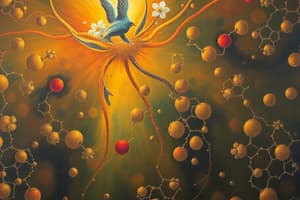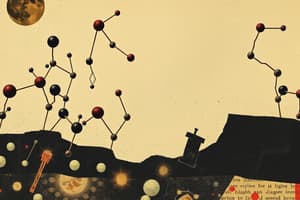Podcast
Questions and Answers
What is the name of the molecule that forms the backbone of sphingolipids?
What is the name of the molecule that forms the backbone of sphingolipids?
Sphingosine
What type of linkage is formed between a fatty acid and sphingosine in sphingolipids?
What type of linkage is formed between a fatty acid and sphingosine in sphingolipids?
Amide linkage
Most natural fatty acids have an odd number of carbon atoms.
Most natural fatty acids have an odd number of carbon atoms.
False (B)
Saturated fatty acids contain no double bonds between carbon atoms.
Saturated fatty acids contain no double bonds between carbon atoms.
Which of the following is NOT a characteristic of trans fatty acids?
Which of the following is NOT a characteristic of trans fatty acids?
What is the name of the process that involves degradation of unsaturated fatty acids by reactive oxygen species?
What is the name of the process that involves degradation of unsaturated fatty acids by reactive oxygen species?
Which type of lipid assembly is characterized by a spherical structure with the hydrophobic tails pointing inward and the hydrophilic heads facing outward?
Which type of lipid assembly is characterized by a spherical structure with the hydrophobic tails pointing inward and the hydrophilic heads facing outward?
What is the opposite of viscosity in a lipid bilayer?
What is the opposite of viscosity in a lipid bilayer?
The strength of Van der Waals interactions is inversely proportional to the fluidity of a lipid bilayer.
The strength of Van der Waals interactions is inversely proportional to the fluidity of a lipid bilayer.
Name the two primary states of lipid bilayers.
Name the two primary states of lipid bilayers.
Which factor is NOT a determinant of the melting point (Tm) of a lipid bilayer?
Which factor is NOT a determinant of the melting point (Tm) of a lipid bilayer?
What is the name of the analytical technique used to determine the melting point of a lipid bilayer?
What is the name of the analytical technique used to determine the melting point of a lipid bilayer?
Sterols, like cholesterol, are characterized by a four-fused ring system.
Sterols, like cholesterol, are characterized by a four-fused ring system.
What is the key functional group that acts as the polar head in sterols?
What is the key functional group that acts as the polar head in sterols?
Cholesterol is the only sterol found in animal cells.
Cholesterol is the only sterol found in animal cells.
At temperatures below the melting point (Tm), cholesterol increases the fluidity of lipid bilayers.
At temperatures below the melting point (Tm), cholesterol increases the fluidity of lipid bilayers.
Cholesterol significantly decreases the fluidity of lipid bilayers at temperatures above the melting point (Tm).
Cholesterol significantly decreases the fluidity of lipid bilayers at temperatures above the melting point (Tm).
Which of the following statements accurately describes the effect of cholesterol on lipid bilayer phase transitions?
Which of the following statements accurately describes the effect of cholesterol on lipid bilayer phase transitions?
Flashcards
Lipids
Lipids
Biomolecules with diverse structures and a common characteristic of being relatively hydrophobic.
Amphipathic
Amphipathic
The property of having both polar (hydrophilic) and nonpolar (hydrophobic) regions.
Complex Lipids
Complex Lipids
Lipids that contain fatty acids, categorized into storage lipids and membrane lipids.
Non-Fatty Acid Lipids
Non-Fatty Acid Lipids
Signup and view all the flashcards
Fatty Acids
Fatty Acids
Signup and view all the flashcards
Saturated fatty acids
Saturated fatty acids
Signup and view all the flashcards
Unsaturated fatty acids
Unsaturated fatty acids
Signup and view all the flashcards
Monounsaturated Fatty Acids
Monounsaturated Fatty Acids
Signup and view all the flashcards
Polyunsaturated Fatty Acids
Polyunsaturated Fatty Acids
Signup and view all the flashcards
Cis configuration
Cis configuration
Signup and view all the flashcards
Delta Numbering System
Delta Numbering System
Signup and view all the flashcards
Omega Numbering System
Omega Numbering System
Signup and view all the flashcards
Polyunsaturated Fatty Acids
Polyunsaturated Fatty Acids
Signup and view all the flashcards
Trans Fatty Acids
Trans Fatty Acids
Signup and view all the flashcards
Hydrogenation
Hydrogenation
Signup and view all the flashcards
Lipid Peroxidation
Lipid Peroxidation
Signup and view all the flashcards
Triacylglycerols
Triacylglycerols
Signup and view all the flashcards
Glycerophospholipids
Glycerophospholipids
Signup and view all the flashcards
Head Group
Head Group
Signup and view all the flashcards
Sphingolipids
Sphingolipids
Signup and view all the flashcards
Sphingomyelin
Sphingomyelin
Signup and view all the flashcards
Lipases
Lipases
Signup and view all the flashcards
Secretory PLA2
Secretory PLA2
Signup and view all the flashcards
Bilayer Fluidity
Bilayer Fluidity
Signup and view all the flashcards
Van der Waals interactions
Van der Waals interactions
Signup and view all the flashcards
Hydrocarbon Conformations
Hydrocarbon Conformations
Signup and view all the flashcards
Gel to Liquid Crystalline Transition
Gel to Liquid Crystalline Transition
Signup and view all the flashcards
Transition Temperature (Tm)
Transition Temperature (Tm)
Signup and view all the flashcards
Differential Scanning Calorimetry (DSC)
Differential Scanning Calorimetry (DSC)
Signup and view all the flashcards
Sterols
Sterols
Signup and view all the flashcards
Cholesterol
Cholesterol
Signup and view all the flashcards
Study Notes
Lipids
- Lipids are diverse but generally hydrophobic
- All biomolecules, even lipids, are amphipathic
- Lipids are classified into those containing fatty acids (complex lipids) and those that do not.
Fatty Acids
- Fatty acids are carboxylic acids with hydrocarbon chains containing 4 to 36 carbons.
- Most natural fatty acids have an even number of carbons and are unbranched.
- Saturated fatty acids lack double bonds between carbons in the chain.
- Unsaturated fatty acids contain one or more C=C double bonds in the alkyl chain. Monounsaturated fatty acids have one double bond, and polyunsaturated fatty acids have multiple double bonds.
- Cis double bonds introduce kinks (approximately 30 degrees) into the alkyl chain.
Fatty Acid Nomenclature
- Systematic names (e.g., cis-9-octadecanoic acid), common names (e.g., oleic acid), delta and omega numbering systems.
Double Bonds in Polyunsaturated Fatty Acids (PUFAs)
- Double bonds in PUFAs are not usually conjugated; they are spaced by 3 carbon atoms.
- Examples include linoleic acid (18:2, Δ9,12 or ω-6).
Trans Fatty Acids
- Trans fatty acids form in the presence of metal catalysts used for partial hydrogenation.
- Trans fatty acids increase shelf life, stability at cooking temperatures, and result in solid consistency.
- A trans double bond allows a conformation that mimics the Van der Waals interactions found in saturated fats.
- Trans fatty acids are strongly linked with heart disease.
PUFAs and Lipid Peroxidation
- PUFAs are susceptible to lipid peroxidation due to hydrogen abstraction by free radicals, initiating a chain reaction.
- The peroxidation products include malondialdehyde, 4-hydroxynonenal, and others.
Triacylglycerols
- Triacylglycerols (TAGs) are storage lipids consisting of glycerol esterified to three fatty acids.
- Can be a mixed triacylglycerol.
Glycerophospholipids
- Glycerophospholipids are major membrane lipids.
- Two fatty acids are esterified to the first and second hydroxyl groups of glycerol-3-phosphate.
- The phosphoryl group is charged at physiological pH.
- The phosphate group can be further substituted with different head groups. Examples include phosphatidylethanolamine, phosphatidylcholine, phosphatidylserine, and phosphatidylglycerol.
- Unsaturated fatty acids commonly connect to C2 of glycerol-3-phosphate.
Sphingolipids
- Sphingolipids are membrane lipids with sphingosine as their backbone.
- A fatty acid is linked to sphingosine by an amide linkage.
- A polar head group is attached to sphingosine.
- Glycosphingolipids contain sugars and are located in the outer leaflet of plasma membranes.
- Sphingomyelin is structurally similar to phosphatidylcholine.
Lipids and Lipases
- Lipids can be hydrolyzed by lipases.
- Phospholipase A1, A2, C, and D, are types of lipases.
Cholesterol
- Sterols have a steroid nucleus with four fused rings, a hydroxyl group, and various nonpolar side chains.
- Examples include Cholesterol.
- Cholesterol acts as a fluidity buffer in cell membranes. Below the transition temperature cholesterol disrupts close packing, increasing fluidity. Above the transition temperature, cholesterol reduces acyl chain mobility and decreases fluidity. Cholesterol also broadens/abolishes phase transitions.
Lipid Assemblies
- Lipid assemblies include micelles, bilayers, and liposomes.
Bilayer Fluidity
- Bilayer fluidity is the opposite of viscosity and is inversely related to lipid packing.
- It's influenced by the strength of van der Waals interactions (increased by saturated fatty acids) and increased unsaturation, size of head groups, and temperature.
Hydrocarbon Conformations
- Hydrocarbon conformations include eclipsed and staggered forms, and anti and gauche conformations.
- Staggered conformations are typically the most stable and common (especially the anti form).
- Anti conformations maximize packing and are favored at lower temperatures.
- Gauche conformations are more common at higher temperatures.
Two States of Bilayer Lipids
- Bilayer lipids exist in gel and liquid-crystalline phases.
- The transition temperature (Tm) depends on lipid composition (number of carbon atoms, degree of unsaturation, size of head groups).
- Tm for biological membranes is typically between 10-40 °C.
Studying That Suits You
Use AI to generate personalized quizzes and flashcards to suit your learning preferences.




